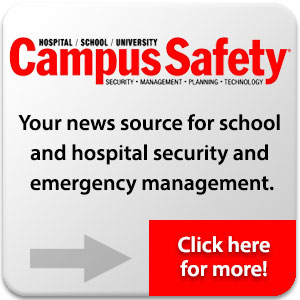The vast majority of U.S. schools, institutions of higher education, and healthcare facilities rely on security cameras to help protect their campuses, and most use this equipment daily, according to the 2022 Campus Safety Video Surveillance Survey. These systems have become the workhorses that most campus public safety, security, and emergency management departments use to monitor everything from entrances and exits to parking facilities, pharmacies, visitors, weather conditions, and more.
Because video surveillance is such an integral part of campus safety and security, these solutions must be properly maintained and, on occasion, upgraded or replaced. That’s why this year’s survey also asked about system maintenance and replacement, as well as who is responsible for those tasks, be they systems integrators, security contractors, onsite personnel, or others.
Nearly 600 campus security, law enforcement, and other technology professionals participated in this year’s questionnaire. Read on to see the results.
93% of Campuses Have Security Cameras
Security cameras continue to be extremely popular with campus protection professionals, and their popularity shows no signs of waning. Like last year’s survey, overall, more than nine in 10 (93%) of respondents to this year’s survey said their campus/district or facility has some sort of video surveillance system.
In fact, video surveillance is so critical to campus security and safety that just over half of all of this year’s respondents said they are considering purchasing new cameras or solutions or expanding, updating, or replacing the systems they have in the next two years.
At 57%, institutions of higher education were the most likely to say they are in the market for new or updated systems, compared to K-12 respondents at 47% and healthcare respondents at 52%.
3 in 5 Provide Evidence for Campus Investigations
The reason why video surveillance is so popular is pretty straightforward: it helps security and public safety officers and administrators do their jobs.
“In the current climate, I would hate to think about not having a video surveillance system in place,” said one participant. “We use it every single day — and night. I am the only SRO at my school, and I can virtually patrol the school watching multiple cameras at one time.”
More than three out of five of this year’s survey takers (61%) said their video surveillance systems frequently provide evidence for investigations. At 65% and 63% respectively, healthcare respondents and K-12 school respondents were the most likely to say footage from their cameras frequently assist in their investigations, compared to 54% of respondents from colleges and universities.
More than one in five (21%) of all survey takers believe their cameras frequently prevent crime, although the majority (53%) said their video surveillance systems only sometimes prevent incidents.
Additionally, cameras are used for a wide variety of tasks. More than half of this year’s respondents (52%) indicated their cameras frequently help their departments monitor campus during weather emergencies, athletic events, concerts, protests, and more. Another 32% said their video surveillance systems are sometimes used for these purposes.
Nearly three out of four participants (73%) use their cameras as force multipliers: 36% frequently and 37% sometimes.
The vast majority of schools, institutions of higher education, and healthcare facilities that have video surveillance systems installed use them daily (87%). Seven percent use them weekly.
Surveillance Monitors Many Areas On/Off Campus
Entrances and exits are the most common areas on campus that are monitored by video surveillance systems (90%), while perimeters are the second most common areas monitored by cameras. At 86% and 83%, K-12 school and healthcare respondents were the most likely to have said they monitor their perimeters with cameras, compared to only 67% of colleges and universities.
Hospitals and institutions of higher education are much more likely to use video surveillance to monitor areas prone to theft (52% and 41% respectively) compared to K-12 schools (29%). Schools (46%) are much more likely than college campuses (22%) to verify visitor identity with their cameras. Just under a third of healthcare respondents said they use video surveillance to verify visitors.
Two out of three healthcare respondents said their campus cameras monitor patient waiting rooms (62%) and areas storing medications/pharmacies (69%). Healthcare survey participants were also more likely to say their campuses use cameras to monitor areas with a history of assaults (38%) than their peers from institutions of higher education (23%) and K-12 schools (17%).
Video System Maintenance is a Priority
Maintaining systems and then promptly upgrading or replacing old equipment is critical for the success of any campus security program. This axiom holds true for video surveillance as well.
“Camera systems must be continually monitored and inspected frequently,” advised one survey participant. “Upgrad[ing] and servicing your systems must be made as needed to keep your surveillance system working at an optimum level.”
Nearly six in ten survey takers (59%) said they replace their security cameras when needed. However, nearly one in four respondents said they either don’t know how often (20%) or never (4%) replace their cameras, which is deeply troubling.
Over a third (37%) of respondents said their campuses maintain their video surveillance systems once per year or more. Healthcare respondents are the most diligent, with 45% saying they maintain their cameras at least once per year, compared to only 33% of K-12 respondents, and 38% of colleges and universities. More than four in 10 said they maintain their video surveillance systems “when needed.”
Only 11% of healthcare survey participants don’t know how often their cameras are maintained, compared to 14% of institutions of higher education and 18% of school respondents. Overall, nearly one in five respondents said they don’t know how often (17%) or never (2%) maintain their camera systems, which, again, is quite troubling.
Nearly six in ten (57%) respondents use systems integrators/security contractors to install new or upgraded video surveillance equipment, while more than one in three (36%) have someone in their organization do the installation.
When it comes to maintaining their video surveillance system, 56% of respondents said someone in their organization handles this task, while 44% have a systems integrator/security contractor maintain their cameras.
Campus Video Solutions from the ISG
The nature and size of a campus, whether for a K-12 school, a college or university, a healthcare organization, a government agency or a private corporation, requires some level of video surveillance. Reducing theft, curbing violence, managing traffic and even providing a general sense of well-being are essential to campus safety and security.
The ISG offers trusted solutions from many partners, like LENSEC, that provide video surveillance systems for campuses of any size with single or multiple locations. Your local ISG dealer member can also integrate photo ID card issuance, tracking, visitor management, access control and campus card services into a complete campus-wide solution for you.
Contact us to talk with your local ISG member about solutions for your campus.
Original article written by Robin Hattersley for Campus Safety Magazine.


